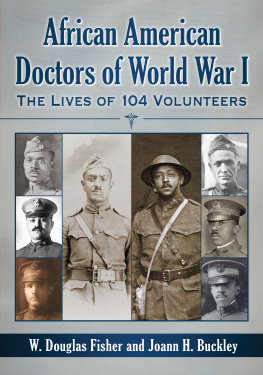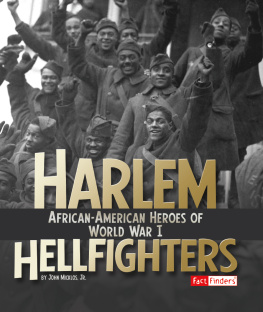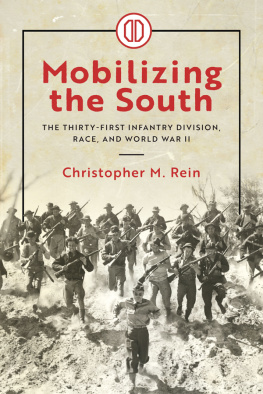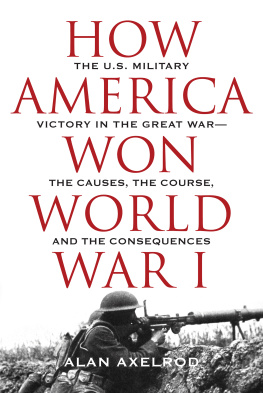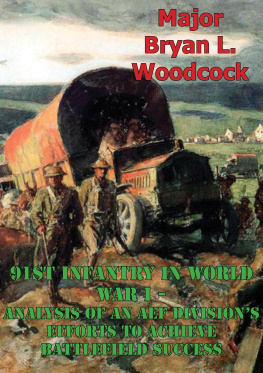HARLEMS
Hell Fighters
Also by Stephen L. Harris
Duty, Honor, Privilege:
New Yorks Silk Stocking Regiment
and the Breaking of the Hindenburg Line
100 Golden Olympians
HARLEMS
Hell Fighters
THE AFRICAN-AMERICAN 369TH INFANTRY IN WORLD WAR I
STEPHEN L. HARRIS
FOREWORD BY ROD PASCHALL

Copyright 2003 by Potomac Books, Inc.
Published in the United States by Potomac Books, Inc. (formerly Brasseys, Inc.). All rights reserved. No part of this book may be reproduced in any manner whatsoever without written permission from the publisher, except in the case of brief quotations embodied in critical articles and reviews.
Maps by Molly OHalloran
Library of Congress Cataloging-in-Publication Data
Harris, Stephen L.
Harlems hell fighters : the African-American 369th Infantry in World War I / Stephen L. Harris ; foreward by Rod Paschall.1st ed.
p. cm.
Includes bibliographical references and index.
ISBN 978-1-57488-386-2 (hardcover)
1. United States. Army. Infantry Regiment, 369thHistory. 2. World War, 19141918Regimental historiesUnited States. 3. World War, 19141918African Americans. 4. United States. ArmyAfrican American troopsHistory20th century. 5. France. ArmeeAfrican American troopsHistory20th century. 6. World War, 19141918CampaignsWestern Front. I. Title.
D570.33369th .H37 2003
940.41273dc21
2002156003
ISBN 1-57488-635-5 (paper)
Printed in the United States of America on acid-free paper that meets the American National Standards Institute Z39-48 Standard.
Potomac Books, Inc.
22841 Quicksilver Drive
Dulles, Virginia 20166
First Edition
10 9 8 7 6 5 4 3 2 1
To Connor Lamar
Everyone should have a grandson like Connor
and to
Sergeants Henry Johnson and William Butler
who were denied the Medal of Honor
because of the color of their skin
ILLUSTRATIONS
PHOTOGRAPHS
MAPS
FOREWORD
This is a regimental history. But also much more. It is a story of bravery, bigotryand jazz. Thats right, Americas signature music. It is an important book because it not only addresses the tale of a National Guard infantry regiment in battle, it delves into the most persistent and tragic flaw in Americas social fabric. And it touches on the rapid internationalization of a special facet of American culture. The author, Stephen Harris, is likely the only writer who could have taken the task of recording and explaining the birth and the initial bloody employment of the 369th U.S. Infantry (created as the 15th New York Infantry Regiment) in the trenches and killing grounds of the Great Wars western front. Harris, fresh from the publication of his Duty, Honor, Privilege, the story of New Yorks Seventh Infantry Regiment in World War I, had acquired the research experience and expertise to deal with John Blackjack Pershings citizen soldiers. However, that fine book was about the absolute upper crust of New York Citys social elite. This book is about the citys blacks fighting in a faraway land under French, not U.S., command. The contrasts between the silk stocking set in combat and Harlems battling heroes cannot be more dramatic.
A grasp of the times is essential. In 1917 the United States was far removed from the nations current globe-straddling and dominating status. It was not then a worldwide recognized military power. It was not considered to be the most important financial center in the world. And it could hardly be described as a culturally influential country. Thanks to Henry Ford and vast stretches of rich earth, it did have the reputation for industrial might and agricultural abundance. But many of its industrial facilities and much of its factory output had been underwritten by Londons banks. In the third year of World War I, this was just beginning to change as the British were reaching ever deeper into their diminished treasury. Culturally, the United States was important but hardly preponderant. The American film industry was burgeoning but so were European movie companies. In letters, art, and music, America was clearly a second- or third-tier attraction. The nation was, however, famous throughout the world for a brutal practice and a demeaning institution. Lynching and humiliating racial segregation had become prevalent throughout the American South, and due to an aggressive and vigilant Northeastern press, these shameful subjects were being widely reported. Militarily, the United States was not a serious contender. True, the U.S. Navy was world class, but Washington commanded a pitifully small ground force, one that could not even catch a murderous invader, the Mexican bandit Pancho Villa. To battle-wise European military leaders, America might be able to supply infantrymen to flesh out loss-laden British, French, and Italian ranks, but the U.S. Army did not have officers knowledgeable enough about modern warfare to contribute leadership, planning, or the administration of large bodies of troops. European generals would have to lead the Americans, and since U.S. war industries were insignificant and inexperienced, Europe would also have to arm the American foot soldiers. Thus in 1917, the sophisticated and lofty Old World looked down on the culturally inferior and socially primitive New World and saw little more than a ready source of cannon fodder for its trenches.
Gen. John J. Pershing, the commander of the American Expeditionary Force (AEF), was not about to let his troops be used as cannon fodder for European generalsexcept a few. Two 28,000-man U.S. divisions were placed under British command, and two divisions composed of black soldiers were put under French command. The 369th Infantry was in the latter category. This book explains in some detail the discrimination and wretched treatment soldiers of the 369th had to suffer to obtain the honor of fighting for their country under the control of generals of another country. The author has an interesting idea on why the U.S. commander turned over black American combat units to the French. The reader might keep in mind that Pershing was probably the most experienced American military leader in commanding or accompanying troops of races or religions that differed from those of white America. He had commanded U.S. African-American troops, Apache, and later, Sioux scouts, and he was with Japanese forces during the Russo-Japanese War of 19041905. Additionally, Pershing trained, armed, and commanded Muslim soldiers of the southern Philippines. However, being shunned by Pershing might have had some advantages, as the author points out. Oddly enough, many American troops who fought under the French and British would later consider themselves better off than the men who were in the AEF.
These years, the first two decades of the twentieth century, may have been one of the most virulent and poisonous periods of American racism. The rising incidence of lynching was accompanied by the formal institution of segregation laws in the South, many of which were based on legal models taken from Illinois, Indiana, and Ohio. Thus, racism was not confined to states below the Mason-Dixon Line. The author aptly describes the slaughter of New York City blacks during the Civil War and accurately points out the stimulus: poor whites fearing to lose jobs to their black neighbors who were accepting lower wages. This phenomenon reached new heights throughout the United States just before and during the first years of the Great War. This was a time when there was a steady march of southern blacks to factory towns in the North, while parts of American industry were displacing some industrial plants southward to avoid unionized white labor. Working-class whites became at first resentful, then angry, and, finallyparticularly in the Southviolent. Harris depicts several forms of bigotry. It was often subtle in the North, openly cruel in the South, and as the author showsin existence among the officer class in France.
Next page

